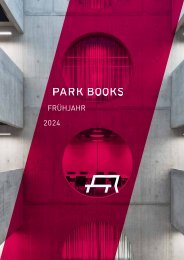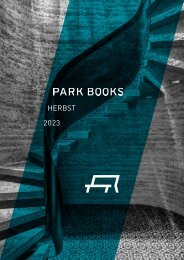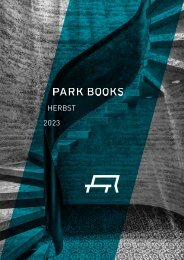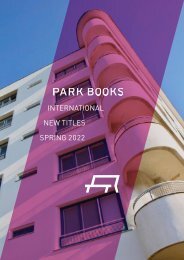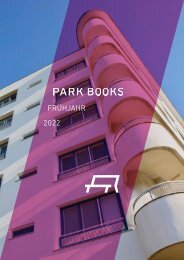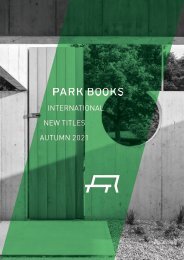Intern-new-titles-Park-Books-2019-20-lowres
New Titles Cataloug 2019/20
New Titles Cataloug 2019/20
Create successful ePaper yourself
Turn your PDF publications into a flip-book with our unique Google optimized e-Paper software.
São Paulo is a prime example among megacities<br />
in emerging countries for how to tackle<br />
major social challenges they face<br />
Presents São Paulo’s prudent and inclusive<br />
policy in urban development and infrastructure<br />
planning<br />
Demonstrates the city’s focus on programs<br />
and usages serving the permanent residents<br />
rather than iconic, tourist-orientated projects<br />
such as museums<br />
Features projects realized and planned since<br />
the 1960s that exemplify the underlying<br />
concepts and strategies<br />
Infrastructures for residents:<br />
São Paulo’s long-term<br />
investment in communal<br />
architecture, a prime example<br />
for how to tackle major social<br />
challenges in mega-cities<br />
Like all mega-cities around the globe, São Paulo faces huge challenges. Yet despite<br />
these manifold and daunting tasks, the Brazilian metropolis has since the 1960s<br />
maintained a prudent policy of investing in communal infrastructure, thus providing<br />
inclusive places and spaces for all of its <strong>20</strong>m-population. While many cities aim for a<br />
“Bilbao-effect” by funding iconic, tourist-orientated projects such as museums or theatres,<br />
São Paulo persistently supports programs and usages that serve its permanent<br />
residents.<br />
This book features a selection of these buildings and projects from five decades. Ranging<br />
from a simple canopy over a public park to vast multifunctional buildings, they provide<br />
spaces for sports and culture, education, healthcare, or gastronomy. Rather than<br />
merely serving a specific purpose, their key role is to be places for people spending<br />
time together.<br />
Andres Leipk is professor of history of architecture<br />
and curatorial practice and director of the<br />
A.M. Architekturmuseum der TUM at Technical<br />
University Munich since <strong>20</strong>12. Prior to this he<br />
has been a curator at Berlin’s Neue Nationalgalerie<br />
and at the MoMA’s department of architecture<br />
and design in New York.<br />
Daniel Talesnik is a research fellow at the A.M.<br />
Architekturmuseum der TUM in Munich. He<br />
graduated in architecture and obtained his PhD<br />
from Columbia University, New York.<br />
Andres Lepik, Daniel Talesnik (eds)<br />
Access for All<br />
São Paulo‘s Architectural Infrastructures<br />
Hardback<br />
224 pages, 181 color and<br />
11 b/w illustrations<br />
21 × 28 cm (8¼ × 11 in)<br />
978-3-03860-163-0 English<br />
sFr. 39.00 | € 38.00 | £ 35.00 | $ 45.00<br />
Available (Europe) | February <strong>20</strong><strong>20</strong> (US)<br />
ISBN 978-3-03860-163-0







